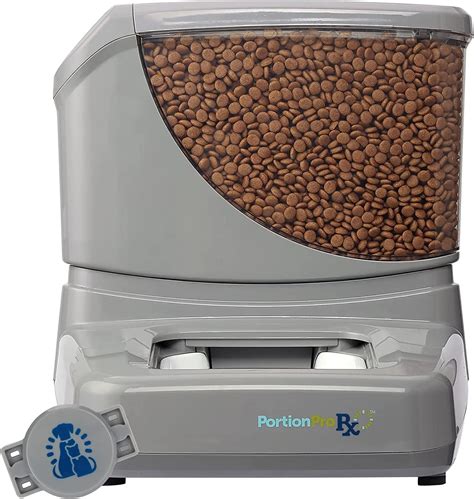In the bustling world of 2025, pet ownership has become more intertwined with technology than ever before. The RFID pet feeder stands as a testament to this advancement, offering cat owners an unparalleled level of convenience and peace of mind.

RFID Pet Feeder vs. Traditional Feeders
Traditional pet feeders relied on manual feeding or timed dispensers, often leading to overfeeding or underfeeding issues. RFID pet feeders, on the other hand, employ radio frequency identification (RFID) technology to control pet access to food.
Key Differences:
| Feature | RFID Pet Feeder | Traditional Feeder |
|---|---|---|
| Food Portion Control | Precise RFID-tagged collar | Manual or timed dispenser |
| Feeding Schedule | Programmable with RFID technology | Rigid feeding times |
| Pet Identification | Unique RFID tags for each pet | No pet identification |
| Monitoring | App-based monitoring of pet feeding habits | Limited or no monitoring |
Benefits of RFID Pet Feeders
RFID pet feeders offer a myriad of advantages over traditional feeders:
- Customized Feeding: RFID tags can be programmed with specific feeding schedules and portion sizes for each pet, preventing overfeeding or starvation.
- Real-Time Monitoring: App-based monitoring allows owners to track their pets’ feeding habits in real-time, ensuring timely adjustments or veterinarian consultations if needed.
- Reduced Waste: Accurate portion control ensures there is no leftover food, reducing food waste and saving money.
- Convenience and Flexibility: RFID pet feeders automate the feeding process, giving owners peace of mind and flexibility while away.
How RFID Pet Feeders Work
RFID pet feeders utilize RFID technology to identify and manage access to food. Here’s the basic mechanism:
- RFID Collar: Each pet is fitted with an RFID collar that contains a unique identification tag.
- RFID Reader: The pet feeder is equipped with an RFID reader that detects the collar tag when the pet approaches the feeding bowl.
- Identification and Authentication: The RFID reader identifies the pet and compares it to the programmed database.
- Food Access: If the pet is authorized, the feeder dispenses the correct portion and records the feeding time.
Choosing the Right RFID Pet Feeder
When selecting an RFID pet feeder, consider the following factors:
- Compatibility: Ensure the RFID tags and collar are compatible with the specific feeder.
- Capacity: Choose a feeder with a food capacity that meets the needs of your pets.
- Programmability: Select a feeder with customizable feeding schedules and portion sizes.
- Monitoring Features: Look for feeders that offer real-time monitoring and notifications.
- Durability: Opt for feeders made of durable materials that can withstand pet activity.
Effective Strategies for Using RFID Pet Feeders
To fully leverage the benefits of RFID pet feeders, employ these effective strategies:
- Program Accurately: Carefully program the feeding schedules and portion sizes to meet the specific needs of each pet.
- Monitor Regularly: Use the app-based monitoring feature to track feeding habits and make adjustments as necessary.
- Train Gradually: Introduce the feeder gradually to allow pets to adapt and avoid stress.
- Clean Regularly: Maintain the feeder and collar by cleaning them periodically to prevent food buildup or collar damage.
- Troubleshooting: Familiarize yourself with troubleshooting tips to resolve any issues that may arise.
Tips and Tricks for Successful Use
- Position the feeder in a quiet and accessible location.
- Use high-quality RFID tags and collars to ensure reliable detection.
- Consider feeding enrichment devices to stimulate mental and physical activity during feeding.
- Store food in airtight containers to maintain freshness and prevent spills.
- Keep documentation related to the feeder and RFID system for reference.
FAQs on RFID Pet Feeders
1. Can RFID pet feeders dispense wet food?
Most RFID pet feeders are designed for dry food. However, some models may accommodate wet food with specific attachments or configurations.
2. Do RFID pet feeders work with multiple pets?
Yes, RFID pet feeders can be programmed to manage multiple pets with different feeding schedules and portion sizes.
3. How often should RFID pet feeders be cleaned?
Regular cleaning is essential. The frequency depends on the usage and environment, but it is generally recommended to clean the feeder at least once a week and the collar as needed.
4. Can RFID pet feeders be hacked?
While RFID technology is generally secure, it is essential to use strong passwords and keep the system updated to minimize the risk of unauthorized access.
Current Status and Future Trends
RFID pet feeders have significantly improved convenience and pet care in recent years. Industry experts predict continued advancements in technology, including:
- Biometric Recognition: Integration of biometric sensors to identify pets based on their unique characteristics, such as facial recognition or paw prints.
- AI-Powered Feeding: Artificial intelligence will enhance feeding by analyzing pet feeding habits and adjusting schedules based on age, activity level, and health data.
- Remote Feeding Options: Advances in connectivity will enable remote access to pet feeders, allowing owners to feed their pets even when they are away from home.
Conclusion
RFID pet feeders have revolutionized pet care by providing an unparalleled level of convenience, precision, and monitoring. By incorporating RFID technology into their routines, cat owners can ensure that their feline companions receive optimal nutrition and care, while enjoying the benefits of automation and peace of mind. As technology continues to advance, RFID pet feeders will become even more sophisticated and essential in the future of pet ownership.





















